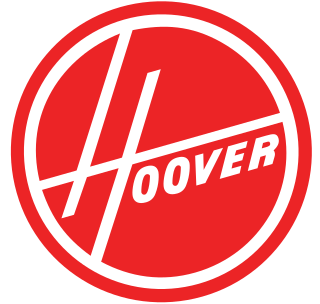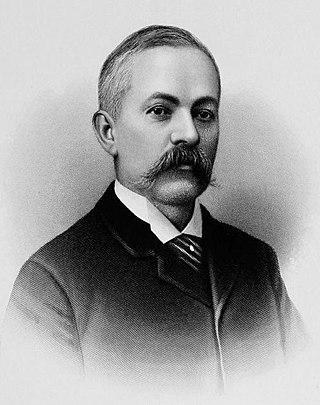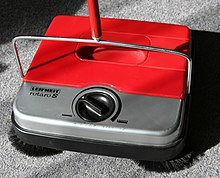
A vacuum cleaner, also known simply as a vacuum, is a device that uses suction, and often agitation, in order to remove dirt and other debris from carpets, hard floors, and other surfaces.

A Roomba is an autonomous robotic vacuum cleaner made by the company iRobot, and was first introduced in September 2002. Roombas have a set of sensors which help them navigate the floor area of a home. These sensors can detect the presence of obstacles and steep drops.

A street sweeper or street cleaner is a person or machine that cleans streets.

The Hoover Company is a home appliance company founded in Ohio, United States, in 1908. It also established a major base in the United Kingdom, where it dominated the electric vacuum cleaner industry during most of the 20th century, to the point where the Hoover brand name became synonymous with vacuum cleaners and vacuuming in the United Kingdom and Ireland. Hoover North America was once part of Maytag, but was sold by Maytag's new owners Whirlpool Corporation in 2007 to Hong Kong multinational manufacturing company Techtronic Industries for $107 million. Hoover International had already split from Hoover North America in 1993, and was acquired by Candy in 1995, which was acquired by Haier in 2019.

iRobot Corporation is an American technology company that designs and builds consumer robots. It was founded in 1990 by three members of MIT's Artificial Intelligence Lab, who designed robots for space exploration and military defense. The company's products include a range of autonomous home vacuum cleaners (Roomba), floor moppers, and other autonomous cleaning devices.
Kirby Opco, LLC, doing business as The Kirby Company, is a manufacturer of vacuum cleaners, home cleaning products and accessories, located in Cleveland, Ohio, United States. It is a division of Right Lane Industries. Dealers, sales reps, service centers, and distributors are located in over 50 countries. Kirby Vacuums are sold via door-to-door or though arranged-scheduled in-home demonstrations via their website and the company is a member of the Direct Selling Association. The Kirby website can also take vacuum cleaner orders and ship directly to the customer as well, without having to arrange for a scheduled an in-home demonstration. All Kirby Vacuum Cleaners are built in both Edgewater, Cleveland, Ohio and Andrews, Texas, United States.

Swiffer is an American brand of cleaning products that is made by Procter & Gamble. Introduced in 1999, the brand uses the "razor-and-blades" business model, whereby the consumer purchases the handle assembly at a low price, but must continue to purchase replacement refills and pads over the lifespan of the product. Swiffer has become a half-billion dollar brand in fifteen countries.

The Electrolux Trilobite is a robotic vacuum cleaner manufactured by the Swedish corporation Electrolux. It takes its name from the extinct arthropod, which scoured the ocean's floor.

Carpet cleaning is performed to remove stains, dirt, debris, and allergens from carpets. Common methods include hot water extraction, dry-cleaning, and vacuuming.

An automated pool cleaner is a vacuum cleaner that is designed to collect debris and sediment from swimming pools with minimal human intervention.
The manual vacuum cleaner was a type of non-electric vacuum cleaner, using suction to remove dirt from carpets, being powered by human muscle, similar in use to a manual lawn mower. Its invention is dated to the second half of the 19th century, when patents were granted to inventors in the United States, Britain, France, and elsewhere.

SEBO is the brand name of vacuum cleaners made by Stein & Co GmbH, a company based in the German town of Velbert. They produce a range of upright and cylinder vacuum cleaners for domestic and commercial use. SEBO stands for SEmigewerbliche BOdenpflege, German for semi-commercial floor care.

James Murray Spangler was an American inventor, salesman, and janitor who invented the first commercially successful portable electric vacuum cleaner that revolutionized household carpet cleaning. His device was not the first vacuum cleaner, but it was the first that was practical for home use. It was the first to use both a cloth filter bag and cleaning attachments. Spangler improved this basic model and received a patent for it in 1908. He formed the Electric Suction Sweeper Company to manufacture his device. William H. Hoover was so impressed with the vacuum cleaner that he bought into Spangler's business and patents.

A central vacuum cleaner is a type of vacuum cleaner appliance installed into a building as a semi-permanent fixture. Central vacuum systems are designed to remove dirt and debris from homes and buildings by sending dirt particles through piping installed inside the walls to a collection container inside a remote utility space. The power unit is a permanent fixture, usually installed in a basement, garage, or storage room, along with the collection container. Inlets are installed in walls throughout the building that attach to power hoses and other central vacuum accessories to remove dust, particles, and small debris from interior rooms. Most power hoses have a power switch located on the handle.

A robotic vacuum cleaner, sometimes called a robovac or a roomba as a generic trademark, is an autonomous robotic vacuum cleaner which has a limited vacuum floor cleaning system combined with sensors and robotic drives with programmable controllers and cleaning routines. Early designs included manual operation via remote control and a "self-drive" mode which allowed the machine to clean autonomously.

Bissell Inc., also known as Bissell Homecare, is an American privately owned vacuum cleaner and floor care product manufacturing corporation headquartered in Walker, Michigan in Greater Grand Rapids. The company is the number one manufacturer of floor care products in North America in terms of sales, with 20% marketshare.

A floor scrubber is a floor cleaning device. It can be a simple tool such as a floor mop or floor brush, or in the form of a walk-behind or a ride-on machine to clean larger areas by injecting water with cleaning solution, scrubbing, and lifting the residue off the floor. With advancements in robotics, autonomous floor-scrubbing robots are available as well.
The Kärcher RC 3000 was a robotic vacuum cleaner created by Kärcher in 2002, and manufactured until January 2015. Unlike other robotic vacuum cleaners of the time, the RC 3000 was designed with a self-service station that allows owners to keep their robots running for longer periods of time. The service station, containing a paper bag, accomplishes this by acting as the collection point for the dirt and dust swept up by the robot.

Melville Reuben Bissell was an American entrepreneur who invented the modern carpet sweeper. The Bissell corporation is named after him.


















